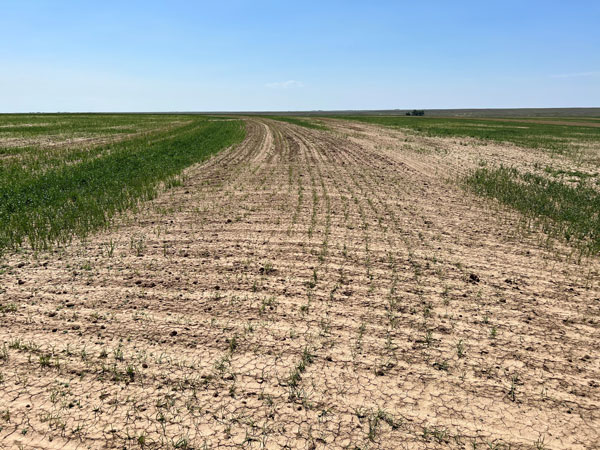The 2023 Wheat Quality Tour took place May 15 - 18, 2023. About 106 people actively scouted hundreds of Kansas wheat fields in 27 groups spread across six routes (Figure 1). The groups left Manhattan and headed to Colby on day 1, from Colby to Wichita on day 2, and finally from Wichita to Manhattan on day 3.

Figure 1. Representation of the six routes (purple, green, pink, yellow, blue, and black) explored during the wheat quality tour. Image courtesy of Wheat Quality Council.
The Kansas wheat crop is currently facing many challenges. After three days and 652 yield estimates from commercial fields – excluding those that looked like they would be terminated with less than 5 bushels/acre potential, the overall 2023 production estimate for Kansas resulting from the tour was 178 million bushels of wheat, compared to 261 and 364 million bushels estimated by the tour in 2022 and 2021, respectively. This is the first time in many years that the estimate is below 200 million bushels, reflecting the widespread drought, heat, freeze, and hail conditions that impacted the Kansas wheat crop in 2023. Weather conditions during the next 2-3 weeks will be crucial in determining where the final grain production will actually land.
Drought stress
The entirety of the state’s wheat crop has suffered from drought stress during the 2022-23 growing season, with levels of drought differing among subregions. Symptoms of drought stress were milder in the eastern portion of the state (younger leaves curled, abortion of older leaves, and yellowing of lower canopy), and got progressively worst towards the western region (extremely reduced plant height and biomass, and delayed development). Many of the sampled fields were well into the reproductive stages of development, such as flowering and grain elongation, and were only 9-12 inches tall due to the prolonged stress (Figure 2). For fields under these conditions, yield estimates of 8-15 bushels per acre were common. The lack of growth will reduce the crop’s yield potential, create difficulties during harvest, and leave virtually no residue behind that could benefit next season’s summer crop.

Figure 2. Drought-stressed wheat fields got progressively worse as the group moved from central to western Kansas. Symptoms included decreased crop biomass production and height, curled leaves, abortion of older leaves, and yellowing of lower canopy. Photos taken by Romulo Lollato, K-State Research and Extension.
Conditions deteriorated as the group moved from northwest to southwest Kansas, where drought stress has been more severe (Figure 3). A very large area, spanning as far north as southern Wichita County to the KS-OK border, and from the KS-CO border to as far east as around Barber/Pratt counties, has been severely affected by drought and will have a large abandonment. Many of the producers around the state have already taken the decision to terminate their wheat crop. Visiting with growers in different regions, the average crop abandoned reported in the southwest part of the state ranged from about 25% to as much as 90%. For the crop that remains with some potential, precipitation within the next few days is essential to improve crop conditions and ensure some harvestable grain yield. If no rain occurs in the next few days, producers will have to face the decision of whether to harvest a crop with extremely limited yield potential or terminate the crop and switch to a summer crop (should moisture conditions improve for planting).

Figure 3. A vast majority of wheat planted in the southwest part of Kansas and northwest Oklahoma will be abandoned due to severe and prolonged drought stress. Photo by Romulo Lollato, K-State Research and Extension.
Heat stress
The second largest concern affecting the 2023 winter wheat crop in Kansas is heat stress. Many fields in the central portion of the state, with an area spanning from Saline County and south down to Sumner County, are showing signs of heat stress, such as scorched white heads (Figure 4). Heat stress interacts with drought stress and thus the symptoms tended to be worse than usual this year.

Figure 4. Wheat field in Saline County, Kansas, showing signs of head scorching likely due to heat stress. Photo taken by Jay Wisbey, K-State Research and Extension.
Freeze damage
Most of the state is showing symptoms of freeze damage, not only in the leaves but also in the heads (Figure 5). Burnback of leaf tissue resulting from a freeze should be mostly cosmetic and not result in yield reduction, but damage to the heads can reduce yield potential. Freeze injury seems to be widespread across the state but with a fairly low within-field incidence of damaged heads. If the crop has enough moisture from here onwards, it should help compensate for the lost tillers, and yield reductions from this problem might be minimal. If the crop has been severely damaged by a freeze, yield losses might be severe enough to justify no further investment in the crop.

Figure 5. White heads showing symptoms of freeze damage to a wheat field in Reno County, Kansas. Photo by Romulo Lollato, K-State Research and Extension.
Summary
The above factors are a few of the major challenges that the 2023 Kansas wheat crop is currently facing. While each of those factors could restrict wheat yields to a certain extent, the largest uncertainty when estimating wheat production at the state level at this time of year is the percent area abandonment (which may be historically high due to the severe prolonged drought), as well as weather remaining to occur during grain filling. Because the crop has been severely drought-stressed for the majority of the growing season in western and parts of central Kansas, the recent cool and moist conditions during grain fill should help ensure that the current potential of the crop is attained.
Romulo Lollato, Extension Wheat and Forages Specialist
lollato@ksu.edu
Tags: yield potential wheat Wheat Quality Tour wheat plot tours